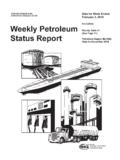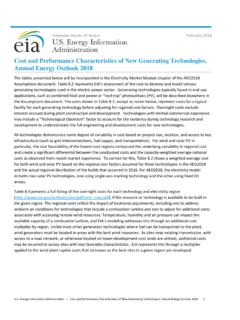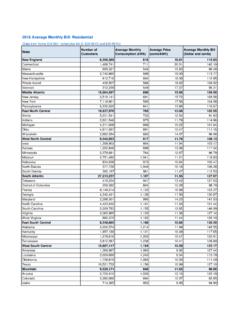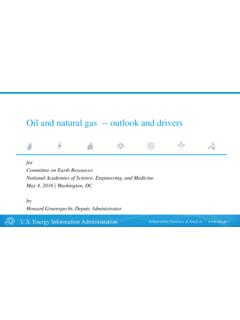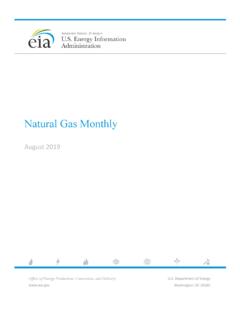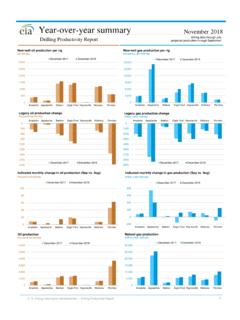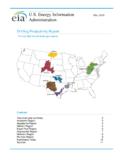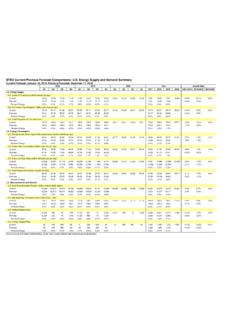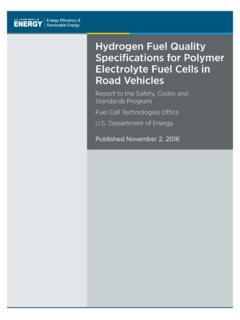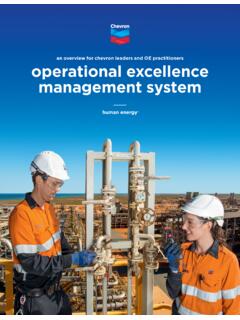Transcription of Country Analysis Executive Summary: Egypt
1 1 Country Analysis Brief: Egypt Last updated May 24, 2018 Overview Egypt is the largest non-OPEC oil producer in Africa and the third-largest dry natural gas producer on the continent. The Country also serves as a major transit route for oil shipped from the Persian Gulf to Europe and to the United States. Egypt is the largest oil producer in Africa outside of the Organization of the Petroleum Exporting Countries (OPEC) and the third-largest natural gas producer on the continent following Algeria and Nigeria. Egypt plays a vital role in international energy markets through its operation of the Suez Canal and the Suez-Mediterranean (SUMED) Pipeline. The Suez Canal is an important transit route for oil and liquefied natural gas (LNG) shipments traveling northbound from the Persian Gulf to Europe and to North America and for shipments traveling southbound from North Africa and from countries along the Mediterranean Sea to Asia. Fees collected from these two transit points are significant sources of revenue for the Egyptian government.
2 The 2011 revolution led to an economic downturn, and the Country experienced a sharp decline in tourism revenue and foreign direct investment, according to the International Monetary Fund (IMF). However, economic conditions have improved over the past few years, and financial support from the United Arab Emirates (UAE), Saudi Arabia, and Kuwait has helped Egypt address its increasing domestic demand for As part of the conditions outlined by the IMF s economic reform package, the Egyptian government is implementing a reform program that will eliminate energy subsidies to reduce spending and strengthen its fiscal position. Energy subsidies are expected to decline to of GDP in fiscal year (FY) 2017 18 (ending June 30, 2018), from a peak of of GDP in FY 2013 E nergy subsidies have contributed to Egypt s large budget deficit and to financial challenges for its national oil company, the Egyptian General Petroleum Corporation (EGPC). Subsidies have also deterred foreign operators from investing in the sector.
3 However, quicker-than-expected progress on implementing reforms and recent natural gas discoveries have led to renewed interest among foreign investors in Egypt s energy sector. 2 Sector Organization Oversight and management of the petroleum sector falls under five state-owned enterprises (SOE), according to Egypt s Ministry of Petroleum:3 Egyptian General Petroleum Corporation (EGPC) Egyptian Natural Gas Holding Company (EGAS) 3 Egyptian Petrochemicals Holding Company (ECHEM) Egyptian Mineral Resources Authority (EMRA) Ganoub El-Wadi Holding Company (Ganope)ECHEM is responsible for developing the petrochemical sector, and EMRA is responsible for mineral resources assessment and geological mapping of the Country . EGPC and Ganope both manage upstream oil activities and issue upstream licenses. Ganope specifically focuses on activity in the southern region, and EGPC on the rest of the EGAS oversees the development, production, and marketing of natural gas and is also responsible for organizing international exploration bid rounds and awarding natural gas exploration licenses.
4 EGAS and EGPC participate with international companies to develop and operate oil and natural gas International oil companies (IOCs) play a large role in Egypt s upstream oil sector, holding shares in producing assets in partnership with EGPC. BP, Eni, Royal Dutch Shell (through the acquisition of BG), and Apache are the major oil and natural gas companies active in Egypt . The first three companies have primarily invested offshore, and Apache has invested in the onshore Western Desert, where Shell and Eni are also The downstream sector is state-controlled and does not have any private investment, with the exception of marketing and storage activities, leaving EGPC and its subsidiaries as the sole Petroleum and Other Liquids Egypt 's oil consumption currently outpaces oil production, and one of the Country s major challenges is to satisfy increasing oil demand amid falling production. Estimates of Egypt s crude oil reserves vary across sources. The Oil & Gas Journal (OGJ) estimates that proven reserves in Egypt have held at a constant billion barrels since 2011, an increase from billion barrels in However, according to the Economist Intelligence Unit (EIU) and 2017 BP Statistical review of World Energy, Egypt s proven reserves have declined from a peak of approximately billion barrels in 2010 to about billion barrels in 2016.
5 According to the EIU, the decline in reserves is a result of maturing oil fields and a lack of new discoveries to fully offset the Crude oil production has been steadily declining over the past decade as a result of the overall decline in output from its legacy onshore fields. Egypt has maintained a sustained level of exploration activity, but many of the significant finds have been natural gas rather than oil. In 2017, Egypt 's petroleum and other liquids production averaged 666,000 barrels per day (b/d) (Figure 2). Most of the crude oil production in Egypt comes from the Western Desert and Gulf of Suez, and the remainder is produced in the Eastern Desert, Sinai, Mediterranean Sea, Nile Delta, and Upper Egypt . However, condensate and natural gas liquids production have increased over the past decade as a result of increasing natural gas production, partially offsetting declines in crude oil One of Egypt 's main challenges is to satisfy increasing domestic oil demand amid falling production.
6 Egypt s oil consumption currently outpaces its oil production. Total crude oil consumption increased by approximately 16% since 2007, averaging 802,000 b/d in 2017, and it is expected to continue growing, even when accounting for the phasing out of subsidies. 4 Refining and Refined Oil Products Egypt has the largest oil refining capacity in Africa, although it operates well below capacity. Egypt s aging refineries lack the capacity to produce higher-end petroleum products, relying on imports to make up for the shortfall. Egypt has the largest refining sector in Africa, but most of the refineries are operating at levels lower than capacity because of aging and maintenance issues. Its refineries mostly process domestically produced crude oil, and refined products are mostly sold to local markets. The Egyptian government has sought to expand its refining capacity, but a number of upgrades and greenfield refineries have been delayed. A 60,000 b/d planned expansion of the MIDOR refinery was expected to be finished by 2018, but completion has been delayed until the early 2020s.
7 Similarly, the expansion of the Mostorod refinery (Mostorod II project), developed by the Egyptian Refining Corporation (ERC) -- a public-private partnership financed by Qalaa Holdings (formerly Citadel Capitol) and EGPC had an initial completion date of 2017, but construction has stalled because of financing issues. Construction of this expansion is likely to continue, but it is unclear if it will be finished by Estimates of Egypt s oil refining capacity vary. The 2017 OPEC Annual Statistical Bulletin and OGJ estimate Egypt s refining capacity at 726,300 b/d and 727,000 b/d, respectively, while the 2017 BP Statistical review of World Energy has a higher estimate at approximately 810,000 Nevertheless, all these estimates qualify Egypt as the largest holder of oil refining capacity in Africa. A bottom-up approach of estimating total refining capacity by calculating the topping capacity of each of Egypt s refineries results in a capacity of 721,500 b/d, as illustrated in the table below.
8 5 Table 1. Egypt 's oil refineries, 2018 Refinery Operator Location Ownership Nameplate Capacity (b/d) Cairo Petroleum Refining Co. Mostorod (Cairo) EGPC (100%) 142,000 Alexandria Petroleum Co. Alexandria (El-Mex) EGPC (100%) 100,000 Nasr Petroleum Co. El Nasr EGPC (100%) 143,000 Middle East Oil Refinery (MIDOR) Alexandria EGPC (78%), Suez Canal Bank (2%), ENPPI (10%), Petrojet (10%) 100,000 Amreya Petroleum Refining Co. Amreya (Alexandria) EGPC (100%) 75,000 Suez Petroleum Processing Co. Suez EGPC (100%) 68,000 Assiut Petroleum Refining Co. Assiut EGPC (100%) 50,000 Cairo Petroleum Refining Co. Tanta EGPC (100%) 35,000 Nasr Petroleum Co. Wadi Ferain EGPC (100%) 8,500 Total 721,500 Planned expansions Additional Capacity (b/d) Assiut expansion 12,700 MIDOR refinery expansion 60,000 Mostorod refinery expansion 84,000 Total 156,700 Source: Arab Oil & Gas Directory, Egyptian General Petroleum Company, Business Monitor International Ltd., IHS Markit, Middle East Economic Survey According to data from 2017 OPEC Annual Statistical Bulletin, Egypt s refined petroleum output averaged 501,800 b/d in 2016, suggesting that, based on OPEC s figures, refinery utilization was about 69%.
9 13 IHS Markit and BMI Research attribute low utilization rates to aging refineries. Most of Egypt s existing refineries are not complex, which prevents them from efficiently producing the more sought after, higher-end products such as diesel, LPG, and gasoline, and requiring imports to make up for the shortfall in domestic Natural Gas Egypt became a net importer of natural gas in 2015 as a result of growing domestic demand and declining production levels. Substantial natural gas discoveries have generated significant interest among business investors and may potentially boost production and allow Egypt to become a net exporter again in the medium term. Similar to crude oil reserves, estimates of natural gas reserves also vary across publications. OGJ estimates that natural gas reserves in Egypt were a constant trillion cubic feet (Tcf) since 2011, an increase from Tcf in According to the 2017 BP Statistical review of World Energy, Egypt held approximately trillion cubic feet (Tcf) of proved natural gas reserves at the end of 2016, which is an increase from the 2010 estimate of almost 59 Tcf and the fourth-largest amount in Africa, after Nigeria, Algeria, and Total natural gas reserves are expected to significantly increase within the next few years because of the recent natural gas discoveries.
10 Despite new discoveries, Egypt s dry 6 natural gas production declined by 31% from 2012 to 2016, leading to net imports since 2015. Egypt produced approximately billion cubic feet per day (Bcf/d) of dry natural gas and imported Bcf/d in 2016 (Figure 3). To satisfy growing domestic demand, Egypt has had to divert its natural gas supply away from exports to the domestic market and to rely on liquefied natural gas (LNG) imports to address the shortfall in consumption. Egypt acquired two floating storage and re-gasification units (FSRUs) in 2015; plans for a third FSRU were canceled in 2016 because of higher anticipated domestic Much of the natural gas consumed in Egypt is used to fuel electric power plants (Figure 4), and the Egyptian government encourages households, businesses, and the industrial sector to consider natural gas as a substitute for petroleum products and coal. The Egyptian government has fast-tracked the development of the Zohr and Atoll fields and the West Nile Delta (WND) project.

